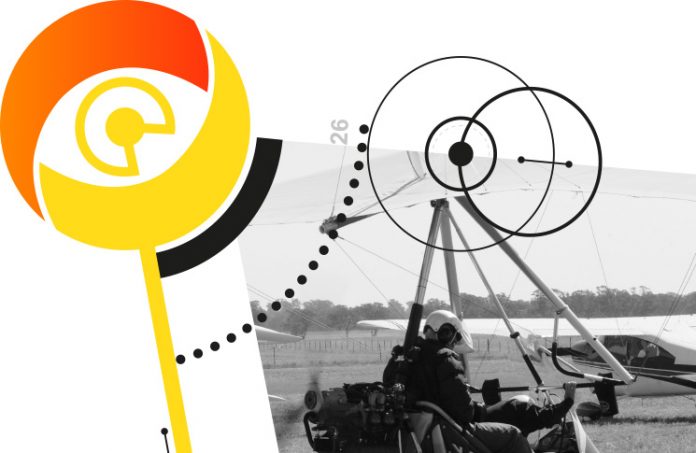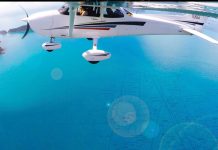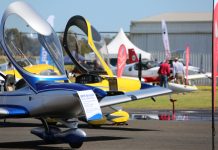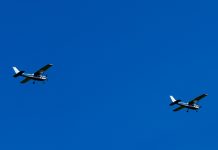Matthew Tomlinson
15 seconds. That was all it took. From the threat first being detected, to a potentially deadly situation, took just 15 seconds. This is the day I learned that a nice day of flying can turn deadly in the blink of an eye. It is also the day I Iearned the limitations of alerted see-and-avoid.
The day began three years ago at my home airfield, Wollongong, in NSW. I had been flying microlights there for a number of years, and knew the local environment well. It was a fine day for flying, and I had enjoyed a nice trip down the coast to explore Jervis Bay. The visibility was excellent, and my passenger and I had taken some stunning photographs of the white sands on Hyams beach. Returning to Wollongong after a couple of hours in the air, the belching chimney stack from the steel works at Port Kembla indicated a gentle sea breeze coming in from the north east. This was quite usual for the time of year, and meant me planning an approach to land towards the north, on runway 34.
With my inbound call complete, I tracked straight towards the field and positioned to overfly at 1500 feet. A quick look down at the windsock—still north-easterly—and I began a gentle descent on the dead-side to the west of the airfield. Things were quiet; there had been no other traffic that I had heard since my 10-mile inbound call. Excellent I thought, that’s one less thing to worry about.
‘Wollongong traffic. Microlight 1234 joins mid-field crosswind runway 34, Wollongong.’
It was the second I let go of the microphone switch that I heard it. ‘Wollongong traffic. Cherokee Alpha Bravo Charlie joins mid-field crosswind runway 34, Wollongong.’
Huh? Instant confusion began to dominate my senses. I hadn’t, up until this point, seen or heard a thing. And now another aircraft was telling me that they were in an identical position to me. I began to frantically look around me in every direction I could, trying to temper my increasing heart rate and adrenalin levels. Nothing. Perhaps he was above me? In a weightshift microlight, with the fabric wing above you, your visibility is great in every direction except directly above. I began a gentle turn to the left and back again to inspect the airspace above me. Nothing. Where on earth was he? There was nothing for it but to ask.
‘Cherokee Alpha Bravo Charlie, this is microlight 1234, your present position please?’
‘Ummm … Alpha Bravo Charlie … is … urrrmmm … joining mid-field crosswind runway 34.’
I strained to interpret the call. It was not a pilot’s voice I knew from Wollongong airport. It was hesitant, and sounded inexperienced. And more importantly, it didn’t really help me understand why I couldn’t see him.
‘Crossing the runway centreline now,’ the voice added, nervously, in a follow-up transmission.
So was I.
It was then that we passed each other.
Flying head-on, with a closing speed of perhaps 150 kt, I was close enough to see a pair of startled eyes looking at me from the cockpit of the Cherokee. I had no time to do anything other than view the situation I found myself in.
And as quickly as it started, it was over. I tried to suppress my true feelings, and instead tried to act as professional as I could muster in the circumstances.
‘Cherokee Alpha Bravo Charlie, microlight 1234 is visual with you now, and be advised that circuits are RIGHT HAND on runway 34 at Wollongong.’
It was now so clear to me. So obvious in hindsight. I was simply looking in the wrong place. Alerted see and avoid is only as good as the pilot making the radio call. If you make a mistake, like joining crosswind from the wrong direction, every other pilot is going to be looking for you in the wrong place. I would argue that in this case, the other pilot’s error that day reduced safety margins below that of (non-alerted) see and avoid. My attention was deliberately drawn away from his location, not towards it. I was looking to the west of the field, while he was arriving from the east. And I believe that this is the main reason I didn’t see him until he was flying right past me. The only thing that saved both of us that day was the luck that we had 200 m of lateral separation between us. That, for me, was too close a call.
I made an effort to talk to the other pilot after we had both landed. I extended a hand and introduced myself as ‘the microlight pilot you nearly collided with’. I was friendly, and we spoke about what had happened. It was a simple mistake by a low-hour PPL-student from Bankstown, who hadn’t paid enough attention to ERSA when pre-flight planning his solo navigation exercise.
I learned a valuable lesson that day. I learned that alerted see and avoid is the best that most of us non-commercial pilots have to assist us in avoiding each other. But I also learned that it is only as good as the pilots who use it.






This reminds me of a recent departure from a country airfield in S.E. Queensland. I gave my taxi call on the correct CTAF and moved away from the bowser. Next, I gave a call to enter the runway and backtrack, having stopped at the holding point. I was about to apply power when fortunately, I happened to look to my left and there was another aircraft doing a touch and go, powering straight past me. I’d heard no radio calls, so I called the aircraft reminding him of the need for radio calls and asking for his intentions. A foreign accent replied that he was heading away to the north east at 1500 feet. If I had entered the runway, a collision would have been impossible to avoid and it made me think about the increasing number of aircraft that try to avoid landing fees by not making radio calls. Given the companies now collecting landing fees on behalf of Councils, including overnight parking fees, this may be an unfortunate trend.
All to often we just miss someone & don’t even know it ! It’s shear luck sometimes that I am still here after flying thousands of hrs in a twin turbo prop operating to all types of strips, How I never collided with some Pvt pilots I’ll never know as a LOT had no idea where they where & what to say on the radio, scares me to think it’s too easy to get a pilots license these days!
Thanks for sharing your near miss! Similar thing happened to me when inbound to Bankstown in the 1990’s. I was approaching (almost overhead) 2RN from the west and just about to press the button to speak with ATC when another aircraft called up inbound at the 1500′ feet -same as me. Upon searching around I spotted this guy about 200m behind me! Back then BK was extremely busy so after making my radio call and advising I was in fact in front of the other guy, I could tell ATC wasn’t impressed, neither was I.
I still reflect on this situation and wonder if I should have broken off and rejoined the sequence behind the queue jumper however this could have caused more of an issue if he hadn’t seen me previously and startled him. I take a very good look around me in all directions when approaching a VFR entry point to make sure I know who is around. I also don’t wait till I’m overhead the VFR point to make the inbound call, I make it a bit earlier.
Come on Airservices it is time to improve EASA AND MARK RH CIRCUITS on the airport drawing. Also mark non std CTAF freq. I had almost the same issue at Thangool which has RH circuits on one Runway. I now print out DAPs for serious airports where I go as at least the word Right hand is on the DAPS drawing.
When going into an unfamiliar airfield I always do what macc does and mark the ERSA diagram with circuit directions if they are not the usual left hand. I will also change my crosswind joining position call to “….. joining RIGHT crosswind for runway ……”
I have flown a lot in the USA and including the direction of circuit (they call it pattern) in circuit calls is quite prevalent and a recommended practice, e.g. “turning left (or right) crosswind/downwind/base for RWY xx
Recently I had a similar situation at my local strip while taxiing out for a check ride in a LS Pioneer 300 Kite. My instructor for the check ride and I had held short of rwy 28 for a touch and go to pass and hearing nothing else we had a look around and the Pioneers bubble gave us good visibility. Seeing nothing I have made the entering and back tracking call for 28 and proceeded. About three hundred metres down and I suddenly spotted another light plane on short final. We immediately exited off to the grass and gave a clearing call but heard nothing from the other aircraft that had spotted us and gone round. By the time we returned from our flight the other plane was not around and we heard no other calls. Perhaps they were on the incorrect CTAF, I guess I’ll never know. It pays to have a real good look around that’s for sure.
I had a situation at a regional airport where a lot of training takes place. I was on short final and an aircraft entered the runway directly facing me. I had, what I thought, made several radio calls inbound, joining downwind, base and advising on short final. As there was almost the whole runway available and there was no danger, I continued my approach and landed. The instructor and student followed me down the runway and we had words. I said to him that a pilot should never enter a runway without looking for aircraft on final. He admitted he had not looked. He said I did not give a radio call. My aircraft was fresh out of a hundred hourly and I discovered that the maintenance engineers had disconnected my headphones and reconnected them to the wrong port, therefore my radio calls were not broadcast. I learned over 50 years ago “never enter a runway without looking for other aircraft”. This is even more critical on an active runway.
Had the Microlight pilot added a few words like…” Crosswind to join down wind RIGHT HAND for Rwy 34″ like we do in Canada, the conflicting pilot may have queried his own incorrect joining procedure….then taken a quick look at the ERSA procedure, to confirm right hand circuits. I also like to draw the ckt direction in my CFS…Canada Flight Supplement.. when non standard.
Hi Peter. I am ‘that’ Microlight pilot (now GA) and your suggestion is a good one. This episode changed my radio calls, and I do indeed now transmit as you suggest. Safe flying!
It’s not only only private pilots that make mistakes. I was once tracking from Windorah to Archerfield. I broadcasted on Charleville CTAF that I was 15 miles west, 7500 to overfly (I always broadcast an overfly regardless of altitude to cater for RPT aircraft). Shortly after a pilot of a Dash-8 broadcasted on the CTAF that they were 30 miles west of YBCV on descent. After overflying I heard BNE CEN ask the Dash-8 (in a curious voice) to confirm if they were in fact west of YBCV. She replied with “eerrrm no sorry we are actually east of YBCV and we are holding 8000 as we have one on the TCAS at 7500 in our 12 o’clock and they have not communicated with us”. I instantly realised she was talking about me. At this stage we were only approximately 8NM apart converging on each other with 500ft separation. Scariest part is that I never did actually spot that Dash-8 pass me!